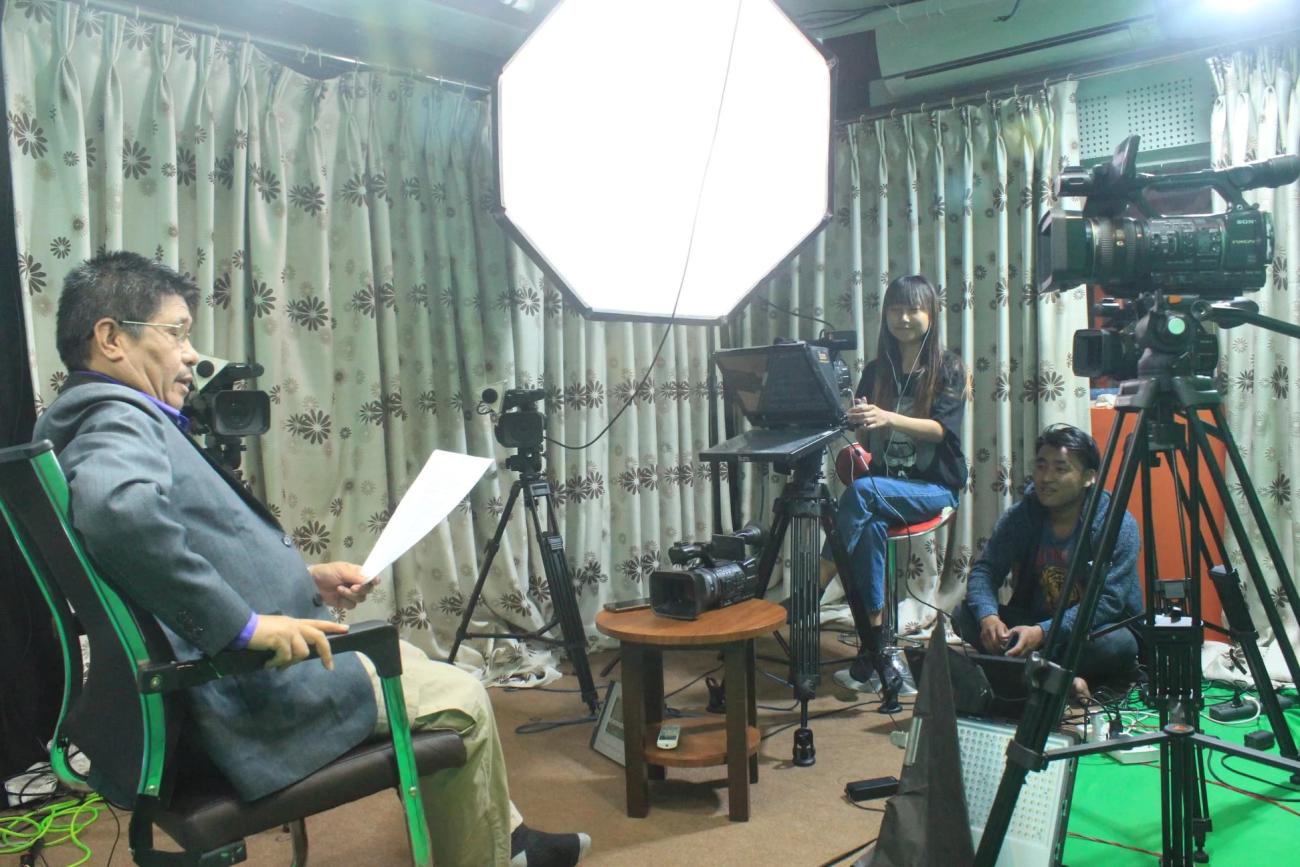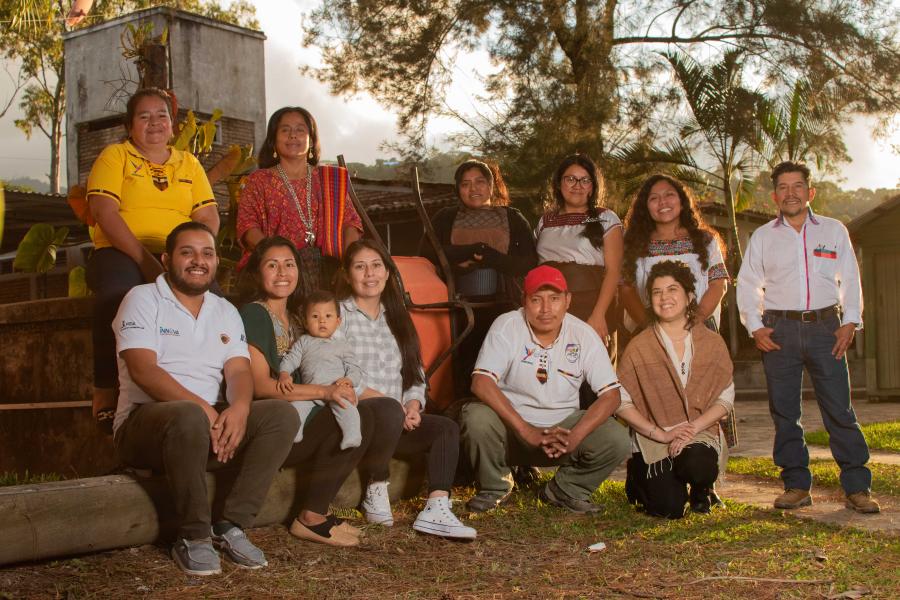
By Dev Kumar Sunuwar (Koĩts-Sunuwar, CS Staff)
Representation matters. Indigenous-led television stations are becoming more popular as cultural and linguistic platforms, making space for Indigenous voices to thrive in a world where mainstream media narratives predominate television networks. These stations serve as a key source of information and entertainment for Indigenous communities, who historically have been marginalized and misrepresented in mainstream media.
Television stations owned and run by Indigenous communities offer a critical alternative to the mainstream media as they report on the problems and violations of the rights of Indigenous Peoples and how they are coping and surviving. Indigenous-led television provides a space for Indigenous Peoples to reclaim their narratives and present themselves to the world on their own terms.
For November 21, World Television Day, Cultural Survival is featuring some of the Indigenous-led television channels unified under the World Indigenous Television Broadcasters Network (WITBN) to highlight the important role that these stations play in giving voice to marginalized Indigenous communities.
Founded in 2008, WITBN is a global alliance of Indigenous broadcasters who aim to retain and strengthen Indigenous languages and cultures. The network alliance connects Indigenous Peoples to amplify their voices and stories while promoting collaboration, content sharing, knowledge exchange, culture, and language preservation through television. They support and amplify Indigenous voices while enhancing global recognition and representation of Indigenous issues. The alliance has members from New Zealand, Canada, Taiwan, and Norway, and is expanding to include Indigenous Peoples in Latin America, Africa, and Asia.
“Indigenous-led television is vital for self-determination, culture, and language resilience,” says Shane Taurima, CEO of Indigenous television station Whakaata Māori and chair of WITBN. “These televisions provide a platform for Indigenous Peoples to tell their own stories and share their unique cultures with the world. WITBN unifies Indigenous broadcasters worldwide to retain and grow our languages and cultures and promote Indigenous storytelling.”
Indigenous-led television stations serve as repositories of cultural heritage, safeguarding and transmitting Indigenous knowledge, languages, and traditions to future generations. These channels are playing a crucial role in preserving cultural identity and ensuring the continuity of Indigenous traditions in an increasingly globalized world.
Taurima says that since its inception, Whakaata Māori, Aotearoa/New Zealand’s national Indigenous broadcaster, has made contributions to the revitalization of Māori culture and language through its dedication to sharing Indigenous stories and creating bridges of understanding between Indigenous and non-Indigenous communities. Television has been an important medium for sharing stories and promoting languages and cultures from Indigenous perspectives.
Indigenous-led television channels are not merely media outlets; they are the catalysts for community empowerment and social change, providing a platform to advocate for their rights, raise awareness about critical issues, and mobilize for collective action. By giving voice to Indigenous concerns and showcasing their achievements, Indigenous-led TV channels also play a key role in bridging the gap between Indigenous communities and mainstream society, promoting dialogue, understanding, and social justice.
Indigenous-led television is rising as a global movement that reflects a growing demand for Indigenous representation, self-determination, and linguistic and cultural preservation in media. Stations like the Aboriginal Peoples Television Network (APTN) in Canada, National Indigenous Television (NITV) in Australia, Whakaata Māori, Taiwan Indigenous Television (TITV), NRK Sámi Television in Norway, and Indigenous Television in Nepal are emerging globally as some of the most effective mediums of mass communication and fundamental means for Indigenous Peoples to maintain their language and defend their rights, serving as the voice of Indigenous Peoples in their languages.
“Indigenous Television serves the diverse needs of the various Indigenous nationalities of Nepal in their languages and also other non-Indigenous Nepalese,” says Kumar (Yatru) Tamang, executive program producer at Indigenous Television. “Indigenous Television is an alternative voice and source of pride for 12 million Indigenous people of Nepal, who can assert their perspectives, share their issues and concerns, and address their sociopolitical needs.”
By broadcasting programs in Indigenous languages and featuring Indigenous stories, struggles, music, and artforms, Indigenous-led television fosters a sense of cultural and lingual pride while serving as an educational resource for non-Indigenous audiences, promoting cross-cultural understanding.
The Sámi, for example, in Norway, Sweden, and Finland. In order to tell Sámi stories in the Sámi language in Sápmi areas, there are three Sámi broadcasters in the region: NRK, SVT Sápmi in Sweden, and YLE Sápmi in Finland.
“The extractive industries operating in Sápmi land are causing negative impacts on livelihood and culture. Similarly, Sámi are also struggling with keeping their language and culture, which really affects the safeguarding of identity,” says Maria Saijets, news editor at SVT Sápmi. “How to make corporations accountable to Sámi is mainly our concern. Mainstream media are also equally responsible for covering issues such as the climate crisis, industrialization, and electrifications that cause harm to Sámi Indigenous Peoples, but they hardly cover [these issues].”
Indigenous-led television stations offer a platform for Indigenous narratives to flourish, showcasing the rich diversity of Indigenous cultures, traditions, and perspectives. They challenge the stereotypical portrayals of the mainstream media and promote a deeper understanding of Indigenous experiences. Through documentaries, news programs, and creative productions, Indigenous-led television has provided spaces for Indigenous storytellers to share their own narratives.
Taurima says, “WITBN extends an invitation to all Indigenous television broadcasters to join the network, as it is open to all Indigenous media broadcasters that promote Indigenous storytelling through Indigenous languages, cultures, and stories. There is so much to be gained by being part of this alliance. We share content and knowledge, and we envision a united and strong Indigenous voice.”

Aboriginal Peoples Television Network (APTN), Canada
Launched on September 1, 1999, Aboriginal Peoples Television Network (APTN) in Winnipeg, Canada, is the first national Indigenous television broadcaster in the world. Today, APTN shares programming by, for, and about Indigenous Peoples with all Canadians as well as viewers around the world. APTN represents a significant milestone for Indigenous Peoples across Canada, and it has since become an important entertainment, news, and educational programming choice for nearly 10 million households in Canada. APTN broadcasts a diverse array of programs that highlight the variety and depth of Indigenous cultures across the country, including news, documentaries, dramas, and cultural shows, all of which contribute to empowering Indigenous communities and fostering greater understanding among all Canadians. The commitment of APTN to the representation of Indigenous Peoples helps to enhance Canada's multicultural fabric.

Whakaata Māori, Aotearoa (New Zealand)
Launched on March 28, 2004, Whakaata Māori is Aotearoa’s national Indigenous broadcaster, based in Aotearoa/New Zealand. It is known in English as Māori Television and serves both English and Māori-speaking audiences. Whakaata Māori’s motto is “mā rātou, mā mātou, mā koutou, mā tātou” (for them, for us, for you, for everyone). Many of the television shows are bilingual in Māori and English. The majority of programming is subtitled, and there is something for everyone to enjoy. Whakaata Māori plays an important role in showcasing authentic Māori narratives, customs, and points of view and is dedicated to advancing Māori culture and language. The organization's programming reflects the rich cultural legacy of New Zealand's Indigenous communities, contributing to the revitalization and celebration of Māori language and identity. Whakaata Māori launched a sister channel, Te Reo, in 2008, which broadcasts exclusively in Māori.

National Indigenous Television (NITV), Australia
National Indigenous Television (NITV) launched on November 1, 2007, and in 2012 it became a part of the Special Broadcasting Service (SBS), a network run by, for, and about Aboriginal and Torres Strait Islander people. It informs, educates, and entertains Indigenous and non-Indigenous audiences about the issues that matter most to Indigenous Australians and is available in 95 percent of Australian homes for free. Its goal is to promote cultural diversity and give Indigenous stories a place to be told.

Taiwan Indigenous Television (TITV), Taiwan
Launched on July 1, 2005, Taiwan Indigenous Television (TITV) is the first Indigenous television station in Asia. Since January 2007, Taiwan Television has been a nonprofit organization and media platform for the Indigenous Peoples of Taiwan. TITV is committed to promoting Indigenous culture and language and provides a platform for showcasing the unique heritage and traditions of Taiwan’s Indigenous communities. TITV’s broadcasts raise awareness about the importance of preserving and revitalizing Indigenous languages and cultures in Taiwan.

NRK Sámi Television, Norway
Established in 1984 and based in Karasjok, Norway, NRK Sápmi Television serves as the voice of the Sámi, the Indigenous Peoples of Norway, Sweden, and Finland. The traditional Sámi settlement (Sápmi) has its own Sámi broadcasters, NRK Sápmi, Norway; SVT Sápmi, Sweden; and YLE Sápmi, Finland. NRK Sámi Television is dedicated to promoting and preserving Sámi language and culture through television. The network’s programming reflects the unique experiences, history, and aspirations of the Sámi community, creating a platform for cultural exchange and appreciation.

Indigenous Television, Nepal
Established on August 9, 2016, Indigenous Television is a multilingual Indigenous community television station based in Kathmandu, Nepal, that aims to speak to, for, and about Indigenous Peoples in their mother tongues. It is also the first and only multilingual Indigenous community television station to date in South Asia. Indigenous Television aspires to give access to Indigenous Peoples to television programs, news, and music in the languages they speak and understand. Indigenous Television launched a sister television channel, ITV-Nepal, on November 21, 2021. Today, Indigenous Television and ITV-Nepal produce and broadcast television programs in 17 different Indigenous languages, including Gurung, Tamang, Sunuwar, Newar, Limbu, Hyolmo, Magar, Tharu, Bantawa Rai, Chamling Rai, Kulung Rai, Sherpa, Thami, Dhimal, Rajbansi, Majhi, and Danuwar, plus English and Nepali, with an additional half-dozen languages coming soon. It has a worldwide presence through satellite, mobile apps, live streaming, and social media platforms.



